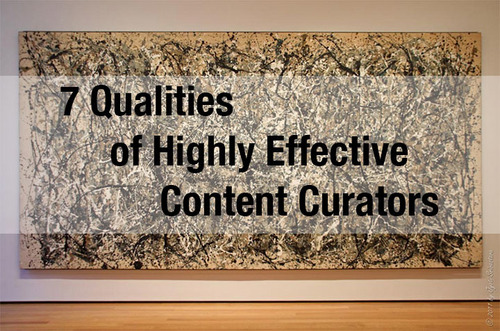Archive for February, 2014
About
See on Scoop.it – Innovative Technologies for Libraries
LibraryCareers.org is a service of the American Library Association designed to promote interest, awareness, and information about careers in libraries.
Its purpose is to serve as a starting point to anyone who may be considering working in a library.
See on librarycareers.drupalgardens.com
Read Full Post | Make a Comment ( None so far )Change Management – How to Tell Your Client That His “Expert” is an Idiot
See on Scoop.it – KM Cyberary | KM Forum
It’s a danger for any consultant, and for most inter-departmental internal project staff: To get the work done, you need to work with someone else who supplies expertise you lack. But when the “expert” turns out to be the wrong …Read »
See on quickbase.intuit.com
Read Full Post | Make a Comment ( None so far )Social Networks and Knowledge Management: An Explorative Study in Library Systems | IGI Global
See on Scoop.it – Bhojaraju Gunjal – Publications
This chapter gives a brief introduction to Knowledge Management (KM) and its components, emphasizing the role Social Networks (SNs) can play on KM. The
See on www.igi-global.com
Read Full Post | Make a Comment ( None so far )InfoSci-OnDemand Search: Scholarly Research Journal Articles and Book Chapters | IGI Global
See on Scoop.it – Bhojaraju Gunjal – Publications
Search for scholarly research journal articles, book chapters, and teaching cases using our full text search to find the research materials you’re looking for.
See on www.igi-global.com
Read Full Post | Make a Comment ( None so far )7 Qualities of Highly Effective Content Curators
See on Scoop.it – Innovative Technologies for Libraries
Excerpt from article written by Dennis Shiao and published on Scoop.it Blog:
“Every time I visit the Museum of Modern Art (MoMA) in New York City, I see something I’ve never seen before.
Wouldn’t it be great if our content collections drew as much interest, respect and admiration as the collections at MoMA? In order to achieve this feat, we need to become highly effective content curators.
Let’s consider seven habits:
1. Focus on Goals
What are your goals around content curation? If you can’t answer that question, stop right now. Stop reading this post, too. Go answer the question, then return when you’re done.
2. Have Empathy
You’ll need to have empathy for your target audience. In other words, the better you understand their thoughts, interests and challenges, the more effective you’ll be at content curation.
3. Be Careful, Cautious and Selective
Make sure you read (and digest) every piece of content you curate. Curate high quality content only, leaving the marginal pieces to the proverbial cutting room floor.
4. Editorialize
Don’t just share content, tell us why you like (or dislike) the piece. What can your target audience learn from reading it and what are the key takeaways? In a sense, editorializing creates a nice blend of creation and curation.
5. Provide Attribution
Providing attribution shows respect and helps drive visibility and awareness to content authors. As you curate, look up the author of the article (or blog post) and explicitly acknowledge them.
6. Understand What’s Timely and Trending
Sharing fresh milk is good. Sharing spoiled milk is rotten.
If you find content that is time sensitive, consider whether the “sharing window” has already passed.
7. Have an Eye for a Great Title
Not everyone will be as thorough as you when reviewing content. A lot of people will click on a link solely because of a compelling title. As you sharpen your curating skills, you’ll begin to figure out what separates great titles from good titles. If you come across a great article that has just a good title, consider changing the title text when you curate…”
Read full original article here:
http://blog.scoop.it/2014/02/13/7-qualities-of-highly-effective-content-curators/
See on blog.scoop.it
Read Full Post | Make a Comment ( None so far )Open Access Scholarly Publishers Association
See on Scoop.it – KM Cyberary | KM Forum
Open Access Scholarly Publishers Association (OASPA)
OASPA offers a forum for bringing together the entire community of Open Access journal publishers.
See on oaspa.org
Read Full Post | Make a Comment ( None so far )The Role of Social Collaboration in Knowledge & Document Management
See on Scoop.it – Knowledge Management Forum
Social business is a real buzzword, but what does it mean, and will it impact your business or organization? In organizations there is often confusion between terms such as Knowledge Management, Document Management, Social networking or communications (Lync, Yammer etc) and more recently Social Business or Social Collaboration. Whilst preparing for a presentation on using Social business tools, I came across this excellent blog (http://alanghamilton.com/2013/12/02/the-role-of-social-collaboration-in-knowledge-document-management-socbiz-km-e20-ibmconnect-ibmsocialbiz/) by Alan Hamilton.I liked the ideas so much that it prompted me to develop this article and share his view. First some definitions or simple explanations Enterprise social networking focuses on the use of online social networks or social relations among people who share business interests and/or activities Knowledge management (KM) is the process of capturing, developing, sharing, and effectively using organizational k
See on rapidbi.com
Read Full Post | Make a Comment ( None so far )Cause and effect, Ishikawa or Fishbone diagrams
See on Scoop.it – KM Cyberary
Cause and effect, Ishikawa, or fishbone diagrams are used to analyse complex situations in a way that clarifies what the root issues are.
See on www.hci.com.au
Read Full Post | Make a Comment ( None so far )Knowledge management 10-point checklist – HCi
See on Scoop.it – KM Cyberary
Implement knowledge management by following these 10 key principles.
See on www.hci.com.au
Read Full Post | Make a Comment ( None so far )








